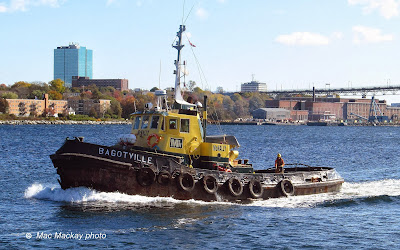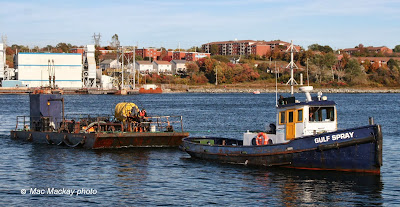Irving Shipbulding Inc is funding the balls, and they being placed by Dominion Diving Ltd. Using their tug Roseway (built in 1960), their work barge DD 2000 (built in the mid-20th century*) and the scow RB Barge (built in 1994) Dominion Diving placed a series of the balls close to shore near Point Pleasant Park's Black Rock beach.
1. The reef balls were lowered to the bottom by crane and divers ensured their correct placement. The barge DD2000 is secured by four anchors.
Once work was completed today, Roseway began the tow back to Dominion Diving's base in Dartmouth Cove.
2.Roseway gets under way. The scow RB Barge was used to transport the reef balls from base to site. (In the background a pusher tug handles a barge** headed for the Northwest Arm.)
3. The deckhand lets out a little more line for the tow home.
3. Underway again.
Foot Notes:
* The barge DD 2000 was once the Dartmouth Marine Slips Work Barge No.1:
4. Pictured in 1976, it was not new then! I have always suspected that it was acquired in the United States with a number of other scows used in construction of the oil rigs at Halifax Shipyard in the 1960s, but have never been able to confirm it.
** The bandy legged legged spud scow in the background of photo number 2 is this item:
5. T.K.L. No.6 was built in 1976 by Sydney Engineering + Dry Dock Co Ltd as the cable ferry Angus MacAskill for the Province of Nova Scotia. It is now owned by R.J.MacIsaac Construction Ltd of Antigonish, NS. In photo 2 it appears to be under the control of the pusher Lina see: http://tugfaxblogspotcom.blogspot.ca/2012/04/tug-lina-history-not-known.html
.




































